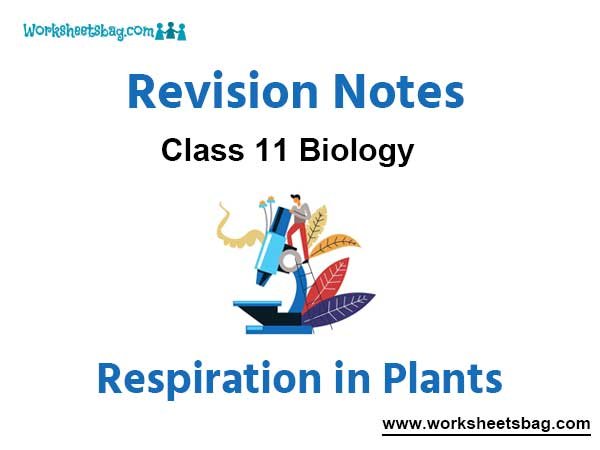Please refer to the Respiration in Plants Notes Class 11 Biology given below. These revision notes have been designed as per the latest NCERT, CBSE, and KVS books issued for the current academic year. Students will be able to understand the entire chapter in your class 11th Biology book. We have provided chapter-wise Notes for Class 11 Biology as per the latest examination pattern.
Revision Notes Chapter 14 Respiration in Plants Class 11 Biology
Students of Class 11 Biology will be able to revise the entire chapter and also learn all important concepts based on the topic-wise notes given below. Our best teachers for Grade 11 have prepared these to help you get better marks in upcoming examinations. These revision notes cover all important topics given in this chapter.
INTRODUCTION

♦ The sequence of use of respiratory substrates Carbohydrate > Fat > Protein > Other substances
SIGNIFICANCE OF RESPIRATION
1. The energy released during respiration is used for the various metabolic processes.
2. Various chemical substances are formed in this process (Carbon skeleton – intermediates of respiration) which are precursors for synthesis of cellular compounds.
DO PLANTS BREATHE?
Plants, unlike animals, have no specialised organs for gaseous exchange but they have stomata and lenticels for this purpose. There are several reasons why plants can get along without respiratory organs.
♦ First, each plant part takes care of its own gas-exchange needs.
♦ Second, plants do not present great demands for gas exchange.
♦ Third, the distance that gases must diffuse even in large, bulky plants is not great.
TYPES OF RESPIRATION

MECHANISM OF CELLULAR RESPIRATION
AEROBIC RESPIRATION :
Different steps are
♦ Glycolysis Occurs in cytosol/cytoplasm
♦ Formation of Acetyl CoA (Link Reaction) Matrix of mitochondria.
♦ TCA cycle or Kreb’s cycle Matrix of mitochondria.
♦ ETS (Electron Transport System) or ETC (Electron transport Chain) Occurs in cristae or inner membrane of mitochondria and Oxidative phosphorylation Occrus in Oxysome head (F1 particle)
Glycolysis/EMP (Embden, Meyerhof, Parnas) pathway
♦ The term glycolysis has originated from the greek words glycos sugar, lysis means splitting.
♦ The glycolysis is common phase between aerobic & anaerobic respiration.
♦ Glycolysis involves a series of ten biochemical enzymatic reactions in cytoplasm.
♦ In Glycolysis, no consumption of oxygen & no liberation of CO2 takes place.
♦ In glycolysis, 1 glucose (6C), break down into 2mol. of pyruvic acid (3C) (Partial oxidation).
FATE OF PYRUVIC ACID :
♦ The fate of pyruvic acid is depends on the cellular need. On the basis of fate of pyruvic acid, respiration mechanism is of following 3 types Aerobic respiration, Alcoholic, Fermentation, Lactic acid Fermentation.
♦ 2 NADH2, produced during the process enter into ETS (In mitochondria) to produce 4ATP (if glycerol phosphate shuttle is present) or 6ATP (if malate aspartate shuttle is present), this ATP formation is called oxidative phosphorylation. (as mentioned in shuttle system)
♦ Substrate level phosphorylation [When the substrate released energy for phosphorylation of ADP (formation of ATP) without ETS is called as substrate level phosphorylation], forms 4 ATP, 2ATP consumed, so 2ATP gain by SLP. (Direct gain )

GLYCOLYSIS / EMP PATHWAY

Formation of Acetyl-Co-A :- (Link/Gateway reaction)
♦ This process connects Glycolysis and Kreb’s cycle so it is called Link reaction or Gateway reaction. During this process Ist time CO2 evolved in respiration.
♦ Acetyl Co-A is a connecting link between glycolysis & kreb’s-cycle. Decarboxylation and dehydrogenation (Oxidative decarboxylation) takes place during formation of acetyl Co-A.
♦ Acetyl Co-A is formed in matrix by enzyme pyruvate dehydrogenase complex. (Mg++, LA (Lipoic Acid), TPP(Thiamine pyrophosphate), NAD+, CoA)

Kreb’s cycle/TCA (Tricarboxylic acid) Cycle / CA (Citric acid) cycle :
♦ This cycle was discovered by H.A. Kreb. (Nobel prize)
♦ TCA cycle occurs in mitochondrial matrix. All the enzymes of TCA cycle, except Succinic dehydrogenase (in the inner mitochondrial membrane) present in matrix.
♦ During Kreb’s cycle acetyl CoA is completely oxidised into CO2.
♦ Krebs cycle is also called Citric acid (CA) cycle because Ist Compound is Citric acid (6C). In this acid, 3 carboxylic groups (COOH) are found so process is also called TCA (Tricarboxylic Acid) cycle
♦ O.A.A. (4C) is the acceptor molecule of Acetyl CoA (2C) in Kreb’s cycle. OAA is reobtained at the end of Kreb’s cycle.
♦ Oxidation or dehydrogenation occurs at 4 places in one Kreb cycle, results in formation of 3NADH2, 1FADH2. Along with1GTP (ATP) produced by substrate level phosphorylation in each turn of TCA cycle.(=12 ATP)
♦ Link reaction and Kreb’s cycle occurs two times during complete oxidation of 1 hexose molecule because by glycolysis one hexose converted into two pyruvic acids and both the molecules have separate link Reactions and Krebs cycles.
DETAILED DIAGRAM OF KREBS CYCLE

ETS & Oxidative Phosphorylation (Terminal Oxidation of NADH2 & FADH2) :
♦ All the reduced hydrogen acceptors like NADH + H+ and FADH2 move to the ETS where they release their hydrogen and reoxidised to NAD+ & FAD+, so that they can again enter into the respiration process.
♦ ETS is the chain of some hydrogen and electron carriers present in the inner mitochondrial membrane.
♦ The significance of ETS is to remove hydrogens from reduced hydrogen acceptors NADH + H+ & FADH2. During this process hydrogen acceptor reoxidised and ATP are produced.
♦ ETS (Respiratory chain) consists of following types of components
(i) FP (Flavoprotein)/FMN (Flavin Mono Nucleotide)
(ii) FeS Protein
(iii) Co-Q (UQ – Ubiquinone)
(iv) Cytochromes.
♦ Cytochromes are cyto.-b, cyto. C1, cyto. C, cyto-a & cyto a3.
♦ During the ETS, NADH + H+ gives it’s 2e/2H+ to FMN in respiratory chain, thus 3 ATP are generated, while FADH2 give it’s 2e/2H+ to CoQ hence only 2 ATP are formed during the process of oxidative phosphorylation.
♦ Enzyme Cytochrome oxidase is responsible for oxidation of cyto. a3 & reduction of O2. (Transfer of electrons from cytochrome a3 to O2)
♦ Cyanide (CN) inhibits the activity of cytochrome oxidase (inhibits the oxidation of cyto-a3 & Reduction of O2).

SHUTTLE SYSTEM
♦ Cytosolic or extra mitochondrial or glycolytic 2NADH2 comes at ETS by two type of shuttles (Only in eukaryotes), as mitochondrial membranes are impermeable for NADH2.
(i) Glycerol phosphate shuttle : (In most of the Eukaryotic cells)
2NADH2 → 2FADH2 = 4ATP 1 Glucose = 36 ATP,
(ii) Malate aspartate shuttle : In Liver, Kidney and Heart cells.
2NADH2 = 6ATP 1Glucose = 38 ATP
♦ In prokaryotes, shuttle mechanism is absent as there is no membrane bounded cell organelle. They always get 38 ATP from aerobic respiration of 1 glucose mol.
The respiratory balance sheet
It is possible to make calculations of the net gain of ATP for every glucose molecule oxidised; but in reality this can remain only a theoretical exercise. These calculations can be made only on certain assumptions that:
♦ There is a sequential, orderly pathway functioning, with one substrate forming the next and with glycolysis, TCA cycle and ETS pathway following one after another.
♦ The NADH synthesised in glycolysis is transferred into the mitochondria and undergoes oxidative phosphorylation.
♦ None of the intermediates in the pathway are utilised to synthesise any other compound.
♦ Only glucose is being respired no other alternative substrates are entering in the pathway at any of the intermediary stages.
But this kind of assumptions are not really valid in a living system; all pathways work simultaneously and do not take place one after another; substrates enter the pathways and are withdrawn from it as and when necessary; ATP is utilised as and when needed; enzymatic rates are controlled by multiple means. Yet, it is useful to do this exercise to appreciate the beauty and efficiency of the living system in extraction and storing energy . Hence, there can be a net gain of 38 ATP molecules during aerobic respiration of one molecule of glucose.
Theoretical energy calculation for complete oxidation of one glucose molecule :

ANAEROBIC RESPIRATION OR FERMENTATION :
♦ Fermentation takes place under anaerobic conditions in many prokaryotes, unicellular eukaryotes and in germinating seeds.
♦ Alcoholic fermentation is used in the formation of beverages (alcoholic drinks) and Bread. Bread become puffed or spongy due to release of CO2 during process.
♦ In anaerobic respiration or fermentation the incomplete oxidation of glucose occurs so not much energy is released, less than 7% of the energy in glucose is released and also not all of it is trapped as ATP.
♦ In Anaerobic respiration or fermentation the net gain of ATP is 2 ATP because during the process, in glycolysis, 4 ATP are synthesised by the substrate level phosphorylation and 2 ATP are consumed, so net gain = 4 2 = 2 ATP (The 2NADH + H+ produced during glycolysis not enter into ETS, they are utilised in order to form alcohol or lactic acid).
Examples of Anaerobic respiration or fermentation :
1. Lactic acid anaerobic respiration : In human muscles (during exercise when oxygen is inadequate).

2. Alcoholic fermentation : In yeast.

♦ Lactic acid fermentation: It is also performed by bacteria Lactobacillus. It is used in curd and other dairy products formation. Curd become sour due to excess lactic acid fermentation.
♦ Butyric acid fermentation: It is performed by bacteria Clostridium butyricum. It is used in curring of tea, tanning of leather, retting of fibres, processing of Tobacco.
RESPIRATION – AMPHIBOLIC PATHWAY
♦ Respiration is not only catabolic process but also anabolic process as it provides many intermediates for biosynthesis of complex organic compounds like fat, proteins etc.
♦ Succinyl COA is important for synthesis of porphyrin ring containing compounds like Chlorophylls, Phytochromes, Cytochromes, Haemoglobin etc.
♦ a-ketoglutaric acid (5c) involved in Amino Acid formation.

RESPIRATORY QUOTIENT (R.Q.)
♦ The ratio of the volume of CO2 released to the volume of O2 consumed, in respiration is called R.Q.

♦ Value of R.Q. depends upon the type of respiratory substrate used & measured by Ganong’s respirometer.
(1) Carbohydrates :R.Q. = 1. C6H12O6 + 6O2 + 6H2O → 6CO2 + 12 H2O + E
(2) Fat / Oil → R.Q. = 0.70 or R.Q. < 1. 2C51 H98O6 + 145O2 → 102 CO2 + 98 H2O +E
Fatty seeds germination-castor, R.Q. < 1
(3) Incomplete oxidation of carbohydrates :
In CAM plants during night : R.Q. = 0. 2C6H12O6+ 3O2 → 3C4H6O5 + 3H2O + Energy
(4) Organic acids : (In succulent xerophytes (CAM plants) at day time)
Malic acid : R.Q. = 1.33. 3C4H6O5 + 3O2 → 4CO2 + 3H2O + Energy
(5) Protein : R.Q. = 0.9 or < 1
(6) Anaerobic respiration : RQ = ¥ (Infinite). C6H12O6 → 2C2H5OH + 2 CO2 + Energy

